Acer AcerNote 370C, AcerNote Light Multimedia User Guide

AcerNote Light Multimedia
User’s Manual

Copyright
Copyright © 1996 by Acer Incorporated. All rights reserved. No part of this publication may be reproduced, transmitted, transcribed, stored in a retrieval system, or translated into any language or computer language, in any form or by any means, electronic, mechanical, magnetic, optical, chemical, manual or otherwise, without the prior written permission of Acer Incorporated.
Disclaimer
Acer Incorporated makes no representations or warranties, either expressed or implied, with respect to the contents hereof and specifically disclaims any warranties, merchantability or fitness for any particular purpose. Any Acer Incorporated software described in this manual is sold or licensed “as is”. Should the programs prove defective following their purchase, the buyer (and not Acer Incorporated, its distributor, or its dealer) assumes the entire cost of all necessary servicing, repair, and any incidental or consequential damages resulting from any defect in the software. Further, Acer Incorporated reserves the right to revise this publication and to make changes from time to time in the contents hereof without obligation of Acer Incorporated to notify any person of such revision or changes.
Acer is a registered trademark of Acer Incorporated. Microsoft, MS-DOS, Windows and Windows 95 are registered trademarks of Microsoft Corporation. IBM and OS/2 are registered trademarks of IBM Corporation. Intel and Pentium are registered trademarks of Intel Corporation. Other brand and product names are trademarks and/or registered trademarks of their respective companies.
ii

IMPORTANT SAFETY INSTRUCTIONS
1.Read these instructions carefully. Save these instructions for future reference.
2.Follow all warnings and instructions marked on the product.
3.Unplug this product from the wall outlet before cleaning. Do not use liquid cleaners or aerosol cleaners. Use a damp cloth for cleaning.
4.Do not use this product near water.
5.Do not place this product on an unstable cart, stand, or table. The product may fall, causing serious damage to the product.
6.Slots and openings in the cabinet and the back or bottom are provided for ventilation; to ensure reliable operation of the product and to protect it from overheating, these openings must not be blocked or covered. The openings should never be blocked by placing the product on a bed, sofa, rug, or other similar surface. This product should never be placed near or over a radiator or heat register, or in a built-in installation unless proper ventilation is provided.
7.This product should be operated from the type of power indicated on the marking label. If you are not sure of the type of power available, consult your dealer or local power company.
8.Do not allow anything to rest on the power cord. Do not locate this product where persons will walk on the cord.
9.If an extension cord is used with this product, make sure that the total ampere rating of the equipment plugged into the extension cord does not exceed the extension cord ampere rating. Also, make sure that the total rating of all products plugged into the wall outlet does not exceed the fuse rating.
10.Never push objects of any kind into this product through cabinet slots as they may touch dangerous voltage points or short out parts that could result in a fire or electric shock. Never spill liquid of any kind on the product.
iii

11.Do not attempt to service this product yourself, as opening or removing covers may expose you to dangerous voltage points or other risks. Refer all servicing to qualified service personnel.
12.Unplug this product from the wall outlet and refer servicing to qualified service personnel under the following conditions:
a.When the power cord or plug is damaged or frayed
b.If liquid has been spilled into the product
c.If the product has been exposed to rain or water
d.If the product does not operate normally when the operating instructions are followed. Adjust only those controls that are covered by the operating instructions since improper adjustment of other controls may result in damage and will often require extensive work by a qualified technician to restore the product to normal condition.
e.If the product has been dropped or the cabinet has been damaged
f.If the product exhibits a distinct change in performance, indicating a need for service
13.Replace battery with the same type as the product's battery we recommend. Use of another battery may present a risk of fire or explosion. Refer battery replacement to a qualified serviceman.
14.Warning! Battery may explode if not handled properly. Do not recharge, disassemble or dispose of in fire. Keep away from children and dispose of used battery promptly.
15.Use only the proper type of power supply cord set (provided in your accessories box) for this unit. It should be a detachable type: UL listed/CSA certified, type SVT/SJT, rated 6A 125V minimum, VDE approved or its equivalent. Maximum length is 15 feet (4.6 meters).
iv

Canadian Department of Communications
Regulatory Statement
This digital apparatus does not exceed Class B limits for radio noise emissions from digital apparatus set out in the Radio Interference Regulations of the Canadian Department of Communications.
Le présent appareil numérique n'émet pas de bruits radio-électriques dépassant les limites applicables aux appareils numériques de la classe B prescrites dans le Réglement sur le brouillage radioélectrique édicté par le ministère des Communications du Canada.
v

FCC Class B Radio Frequency Interference Statement
Note:
This equipment has been tested and found to comply with the limits for a Class B digital device, pursuant to Part 15 of FCC Rules. These limits are designed to provide reasonable protection against harmful interference in a residential installation. This equipment generates, uses, and can radiate radio frequency energy and, if not installed and used in accordance with the instructions, may cause harmful interference to radio communications. However, there is no guarantee that interference will not occur in a particular installation. If this equipment does cause harmful interference to radio or television reception, which can be determined by turning the equipment off and on, the user is encouraged to try to correct the interference by one or more of the following measures:
1.Reorient or relocate the receiving antenna.
2.Increase the separation between the equipment and receiver.
3.Connect the equipment into an outlet on a circuit different from that to which the receiver is connected.
4.Consult the dealer or an experienced radio/television technician for help.
Notice 1:
The changes or modifications not expressly approved by the party responsible for compliance could void the user's authority to operate the equipment.
Notice 2:
Shielded interface cables, if any, must be used in order to comply with the emission limits.
vi

About This Manual
Purpose
This manual discusses the features of the notebook and tells how to use and configure it. This manual, along with the online help, should familiarize you with all aspects of the notebook computer.
Manual Structure
This manual consists of eight chapters and two appendices:
Chapter 1, Getting Started, tells you how to get started with the notebook.
Chapter 2, System Tour, gives a guided and in-depth “tour” of the notebook and its features.
Chapter 3, Power, discusses issues on battery use and includes information on the unique power management system.
Chapter 4, Options, tells how to connect and install hardware options.
Chapter 5, Software, describes how to use certain system applications.
Chapter 6, Setup, explains how to configure the system using the BIOS Setup utility.
Chapter 7, Traveling with the Notebook, includes informative and useful tips on travel.
Chapter 8, Troubleshooting, lists the steps you can take to resolve problems in an easy Q&A format.
Appendix A, Specifications, lists the specifications of the notebook.
Appendix B, Address and Interrupt Tables, shows the address and interrupt tables.
An index is found after the appendices.
vii
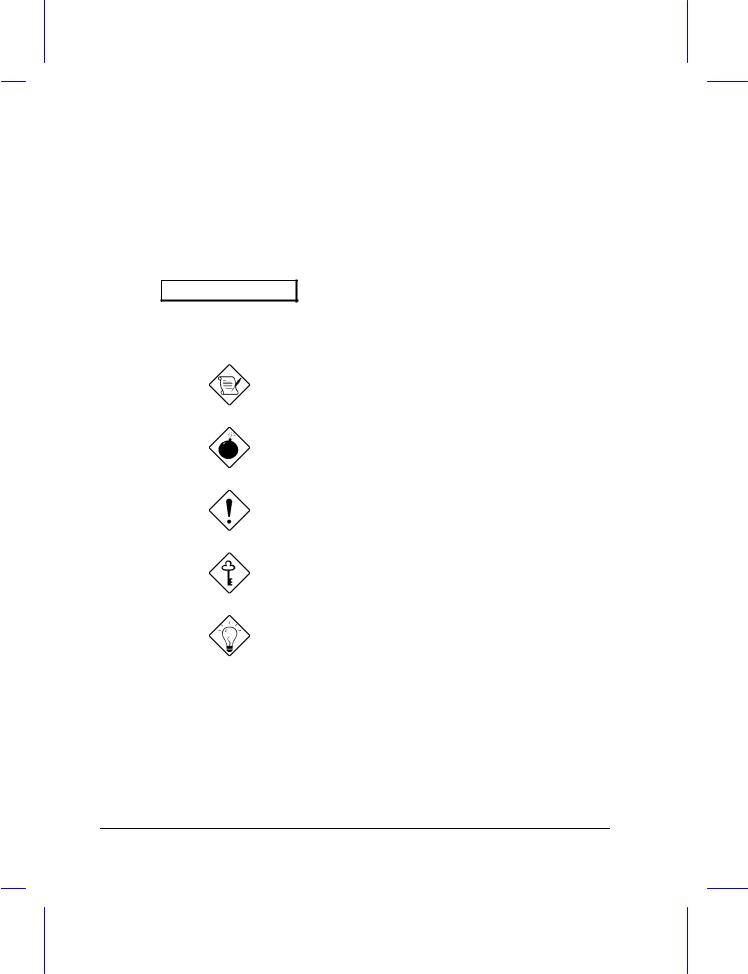
Conventions
The following conventions are used in this manual:
C:\setup, [Enabled], etc.
message displayed
b,e,r, etc
Represent text input by the user, default settings and recommended selections
Denotes actual messages that appear on screen
Represent the actual keys that you have to press on the keyboard
NOTE
Gives bits and pieces of additional information related to the current topic
WARNING
Alerts you if damage may result from doing or not doing specific actions
CAUTION
Gives precautionary measures to avoid possible hardware or software problems
IMPORTANT
Reminds you to take action relevant to the accomplishment of the procedure at hand
TIP
Tells how to complete a procedure with minimum steps through little shortcuts
viii

T a b l e o f C o n t e n t s
1 Getting Started
1.1 |
Item Checklist ....................................................................................... |
1-2 |
|
1.2 |
Taking Care of Your Computer.............................................................. |
1-3 |
|
|
1.2.1 |
Notebook .................................................................................. |
1-3 |
|
1.2.2 |
AC Adapter............................................................................... |
1-6 |
|
1.2.3 |
Battery Pack ............................................................................. |
1-6 |
|
1.2.4 |
Cleaning and Servicing............................................................. |
1-7 |
|
1.2.5 |
Diskettes................................................................................... |
1-7 |
1.3 |
Connecting the Notebook ...................................................................... |
1-9 |
|
1.4 |
Creating Backup and Startup Diskettes for Windows 95 ...................... |
1-11 |
|
1.5 |
Getting Help Online............................................................................. |
1-12 |
|
2 System Tour
2.1 |
Features................................................................................................ |
2-2 |
2.2 |
Display.................................................................................................. |
2-4 |
2.3 |
Indicator Light ....................................................................................... |
2-6 |
2.4 |
Keyboard .............................................................................................. |
2-7 |
|
2.4.1 Keyboard Layout and Special Keys........................................... |
2-7 |
|
2.4.2 Keyboard Ergonomics............................................................. |
2-13 |
2.5 |
Touchpad............................................................................................ |
2-14 |
ix

|
2.6 |
Storage |
............................................................................................... |
2-16 |
|
|
2.6.1 |
Hard Disk................................................................................ |
2-16 |
|
|
2.6.2 |
Internal Media......................................................................... |
2-16 |
|
|
2.6.3 |
PC Card Slots......................................................................... |
2-18 |
|
2.7 |
Ports ................................................................................................... |
|
2-20 |
|
2.8 |
Audio .................................................................................................. |
|
2-22 |
|
2.9 |
Securing your Notebook ...................................................................... |
2-23 |
|
|
|
2.9.1 |
Security Notch ........................................................................ |
2-23 |
|
|
2.9.2 |
Passwords .............................................................................. |
2-23 |
3 |
Power |
|
|
|
|
3.1 |
Battery Pack ......................................................................................... |
3-2 |
|
|
|
3.1.1 |
Battery Pack Characteristics ..................................................... |
3-2 |
|
|
3.1.2 Removing and Installing the Battery Pack................................. |
3-3 |
|
|
|
3.1.3 |
Charging the Battery................................................................. |
3-4 |
|
|
3.1.4 Checking the Battery Level....................................................... |
3-5 |
|
|
|
3.1.5 |
Optimizing Battery Life ............................................................. |
3-6 |
|
|
3.1.6 |
Battery-low Warning ................................................................. |
3-7 |
|
3.2 |
Power Management .............................................................................. |
3-9 |
|
|
|
3.2.1 |
Power Management Modes ...................................................... |
3-9 |
|
|
3.2.2 Advanced Power Management (APM) .................................... |
3-13 |
|
4 |
Options |
|
|
|
|
4.1 |
External Monitor.................................................................................... |
4-2 |
|
|
4.2 |
External Keyboard................................................................................. |
4-3 |
|
x

4.3 |
External Keypad.................................................................................... |
4-4 |
|
4.4 |
External Pointing Device....................................................................... |
4-5 |
|
4.5 |
Printer |
................................................................................................... |
4-6 |
4.6 |
Audio Devices....................................................................................... |
4-7 |
|
4.7 |
File Transfer ...............................................................................Cable |
4-8 |
|
4.8 |
Additional .........................................................................Power Packs |
4-9 |
|
|
4.8.1 ............................................................................. |
Battery Pack |
4-9 |
|
4.8.2 ............................................................................. |
AC Adapter |
4-10 |
|
4.8.3 ........................................................ |
External Battery Charger |
4-11 |
4.9 |
Key Component ..................................................................Upgrades |
4-13 |
|
|
4.9.1 .................................................................... |
Memory Upgrade |
4-13 |
|
4.9.2 ........................................................Hard Disk Drive Upgrade |
4-14 |
|
|
4.9.3 ......................................................................... |
CPU Upgrade |
4-14 |
5 Software
5.1 |
System Software................................................................................... |
5-2 |
|
5.2 |
Sleep Manager...................................................................................... |
5-3 |
|
|
5.2.1 Accessing the Sleep Manager................................................... |
5-3 |
|
|
5.2.2 |
Sleep Manager Functions ......................................................... |
5-6 |
|
5.2.3 |
Running Sleep Manager ........................................................... |
5-9 |
|
5.2.4 Sleep Manager Troubleshooting Tips...................................... |
5-10 |
|
|
5.2.5 |
Uninstalling Sleep Manager ................................................... |
5-11 |
5.3 |
Touchpad Driver ................................................................................. |
5-13 |
|
|
5.3.1 |
Configuring the Touchpad....................................................... |
5-13 |
|
5.3.2 Swapping Buttons for Left and Right Handed Users................ |
5-13 |
|
xi

6 Setup
6.1 |
When to Use Setup ............................................................................... |
6-2 |
|
6.2 |
Entering Setup ...................................................................................... |
6-3 |
|
6.3 |
Basic System Configuration .................................................................. |
6-5 |
|
|
6.3.1 |
Date and Time.......................................................................... |
6-5 |
|
6.3.2 |
Floppy Disk Drives.................................................................... |
6-5 |
|
6.3.3 |
Hard Disk Drive ........................................................................ |
6-6 |
|
6.3.4 Num Lock After Boot ................................................................ |
6-6 |
|
|
6.3.5 |
Memory Test ............................................................................ |
6-6 |
6.4 |
Advanced System Configuration ........................................................... |
6-7 |
|
|
6.4.1 |
Power Management Mode ........................................................ |
6-7 |
|
6.4.2 |
Display Device.......................................................................... |
6-8 |
|
6.4.3 |
Battery-low Warning Beep ........................................................ |
6-9 |
|
6.4.4 |
Suspend Upon Battery-low........................................................ |
6-9 |
|
6.4.5 Modem Ring Wake Up From Standby ...................................... |
6-9 |
|
|
6.4.6 Password Check During Resume.............................................. |
6-9 |
|
6.5 |
System Security .................................................................................. |
6-12 |
|
|
6.5.1 Floppy Disk Drive Control ....................................................... |
6-13 |
|
|
6.5.2 Hard Disk Drive Control .......................................................... |
6-13 |
|
|
6.5.3 System Boot Drive Control ..................................................... |
6-14 |
|
|
6.5.4 |
Boot From CD-ROM ............................................................... |
6-15 |
|
6.5.5 Serial Port Base Address ........................................................ |
6-15 |
|
|
6.5.6 Parallel Port Base Address ..................................................... |
6-16 |
|
|
6.5.7 Parallel Port Operation Mode.................................................. |
6-16 |
|
|
6.5.8 |
Passwords .............................................................................. |
6-17 |
xii

|
6.6 |
Load Setup Default Settings................................................................ |
6-18 |
7 |
Traveling with the Notebook |
|
|
|
7.1 |
Traveling Preparations .......................................................................... |
7-2 |
|
7.2 |
International Traveler’s Warranty .......................................................... |
7-3 |
|
7.3 |
Worldwide Support................................................................................ |
7-4 |
8 |
Troubleshooting |
|
|
|
8.1 |
Q&A...................................................................................................... |
8-2 |
|
8.2 |
Error Messages ..................................................................................... |
8-6 |
ASpecifications
BAddress and Interrupt Tables
B.1 |
System Memory Map ............................................................................ |
B-1 |
B.2 |
I/O Address Map ................................................................................... |
B-2 |
B.3 |
Interrupt Levels ..................................................................................... |
B-3 |
B.4 |
DMA Channels ...................................................................................... |
B-4 |
Index
xiii

|
|
L i s t o f F i g u r e s |
1-1 Write-protecting a 3.5-inch Diskette ...................................................... |
1-8 |
|
2-1 |
Display.................................................................................................. |
2-5 |
2-2 |
Indicator Light ....................................................................................... |
2-6 |
2-3 |
Keyboard Layout ................................................................................... |
2-7 |
2-4 |
Palm Rest ........................................................................................... |
2-13 |
2-5 |
Touchpad............................................................................................ |
2-14 |
2-6 |
Internal Drive ...................................................................................... |
2-16 |
2-7 |
Ports and Connectors.......................................................................... |
2-20 |
2-8 |
Built-in Speakers................................................................................. |
2-22 |
4-1 Connecting an External Monitor ............................................................ |
4-2 |
|
4-2 Connecting an External Keyboard ......................................................... |
4-3 |
|
4-3 Connecting an External Keypad ............................................................ |
4-4 |
|
4-4 Connecting an External Pointing Device ............................................... |
4-5 |
|
4-5 Connecting a Parallel Printer................................................................. |
4-6 |
|
4-6 |
Connecting Audio Devices .................................................................... |
4-7 |
4-7 Using the File Transfer Cable................................................................ |
4-8 |
|
4-8 |
External Battery Charger..................................................................... |
4-11 |
xiv

|
|
L i s t o f T a b l e s |
2-1 |
Indicator Status Descriptions ................................................................. |
2-6 |
2-2 |
Lock Key Descriptions........................................................................... |
2-8 |
2-3 Using the Embedded Keypad ................................................................ |
2-9 |
|
2-4 Windows 95 Key Descriptions ............................................................. |
2-10 |
|
2-5 |
Hot Key List ........................................................................................ |
2-11 |
2-6 |
Touchpad Functions............................................................................ |
2-15 |
2-7 |
Port Descriptions................................................................................. |
2-21 |
3-2 Course of Action for Battery-low Condition ............................................ |
3-8 |
|
4-1 |
Memory Configurations ....................................................................... |
4-13 |
4-2 |
Hard Disk List...................................................................................... |
4-14 |
5-1 Sleep Manager Window Items............................................................... |
5-5 |
|
5-2 |
Swapped Touchpad Functions ............................................................ |
5-14 |
6-1 |
Display Device Settings ........................................................................ |
6-9 |
6-2 |
System Status Descriptions................................................................. |
6-10 |
6-3 Floppy Disk Drive Control Settings...................................................... |
6-13 |
|
6-4 Hard Disk Drive Control Settings......................................................... |
6-13 |
|
6-5 System Boot Drive Control Settings .................................................... |
6-14 |
|
6-6 |
CD-ROM Image Descriptions .............................................................. |
6-15 |
8-1 |
POST Error Messages .......................................................................... |
8-6 |
xv

C h a p t e r 1
Getting Started
Congratulations on your purchase of the AcerNote Light Multimedia notebook computer. Guaranteed and backed by Acer’s world-class support, you can be sure of top-notch performance with your new AcerNote. This chapter guides you through the first few steps on setting up your notebook computer.
Getting Started |
1-1 |

1.1Item Checklist
Carefully unpack the carton and remove the contents. If any of the following items are missing or damaged, contact your dealer immediately.
∙
∙
Notebook computer
Accessory box
∙AC adapter
∙Battery pack
∙External microphone
∙User’s manual
∙Other user documentation
∙System utilities
∙Third-party software and/or documentation
Check for optional items, if any.
1-2 |
User’s Manual |
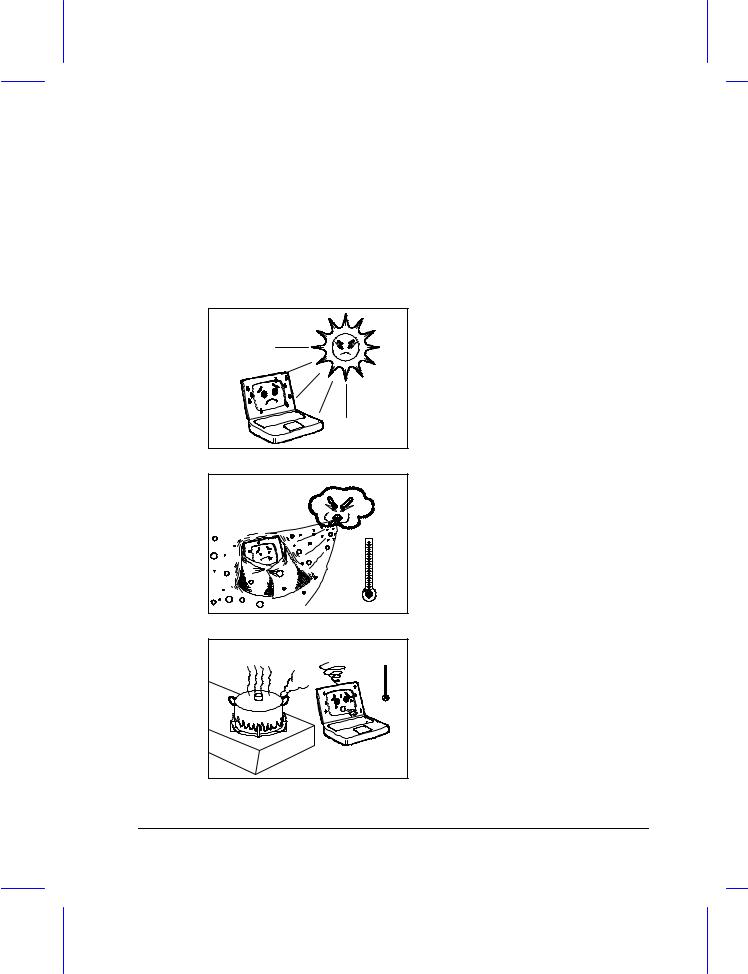
1.2Taking Care of Your Computer
Your computer will serve you well if you take care of it. This section tells you how to care for the notebook. Also, re-read the important safety instructions at the beginning of this manual.
1.2.1Notebook
∙ Do not expose the notebook to direct sunlight. Do not place near sources of heat, such as a radiator.
∙ Do not expose to temperatures below 0ºC (32ºF)
or
above 50ºC (122ºF).
Getting Started |
1-3 |
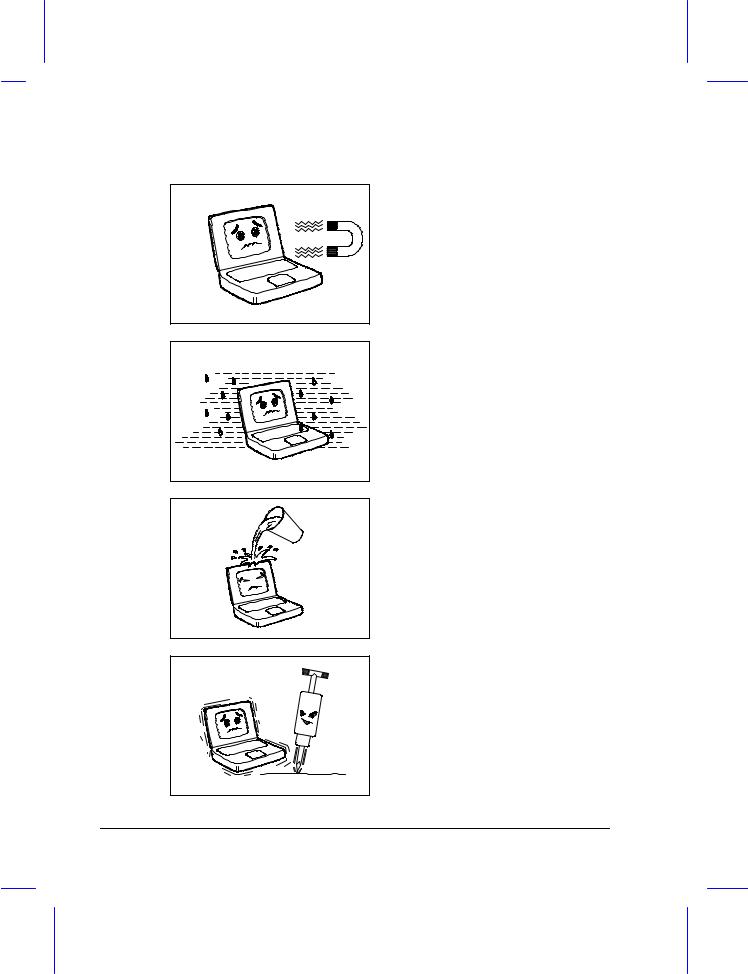
∙ Do not subject the notebook to magnetic fields.
∙ Do not expose the notebook to rain or moisture.
∙ Do not spill water on the notebook.
∙ Do not subject the computer to heavy shock and vibration.
1-4 |
User’s Manual |
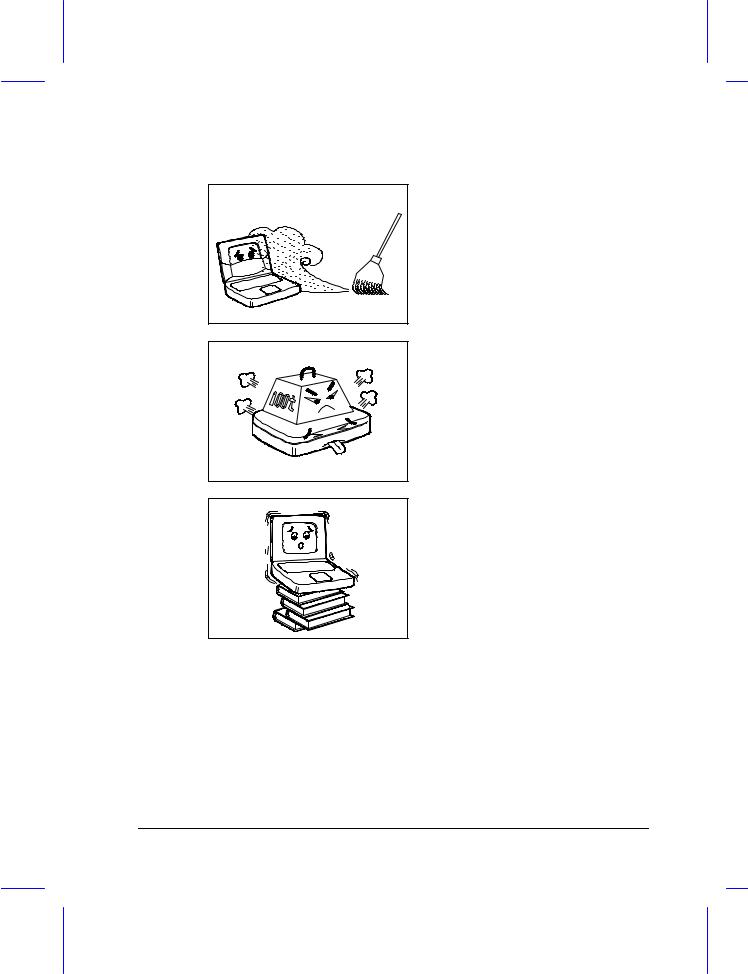
∙ Do not expose the notebook to dust and dirt.
∙ Never place objects on top of the notebook to avoid damaging the notebook.
∙ Never place the notebook on uneven surfaces.
Getting Started |
1-5 |

1.2.2AC Adapter
Here are some ways of taking care of your AC adapter.
∙Do not connect the adapter to any other device.
∙Do not step on the power cord or place heavy objects on top of it. Carefully route the power cord and any cables away from personal traffic.
∙When unplugging the power cord, do not pull on the cord itself but pull on the plug.
∙The total ampere ratings of the equipment plugged in should not exceed the ampere rating of the cord if you are using an extension cord. Also, the total current rating of all equipment plugged into a single wall outlet should not exceed the fuse rating.
1.2.3Battery Pack
Here are some ways of taking care of your battery pack.
∙Use only batteries of the same kind as replacements. Turn the power off before removing or replacing batteries.
∙Do not tamper with batteries. Keep them away from children.
∙Dispose of used batteries according to local regulations. Recycle if at all possible.
1-6 |
User’s Manual |

1.2.4Cleaning and Servicing
When cleaning the notebook, follow these steps:
1.Power off the notebook and remove the battery pack.
2.Disconnect the AC adapter.
3.Use a soft cloth moistened with water. Do not use liquid or aerosol cleaners.
Contact your dealer or see your service technician if any of the following occurs:
∙Notebook has been dropped or the body has been damaged.
∙Liquid has been spilled into the product.
∙The notebook does not operate normally.
See section 7.3 for contact information.
1.2.5Diskettes
Following are some tips on diskette management:
∙Always make backup copies of diskettes that contain important data or program files.
∙Keep diskettes away from magnetic fields and sources of heat.
∙Avoid removing a diskette from a drive when the floppy drive activity light is on.
Getting Started |
1-7 |
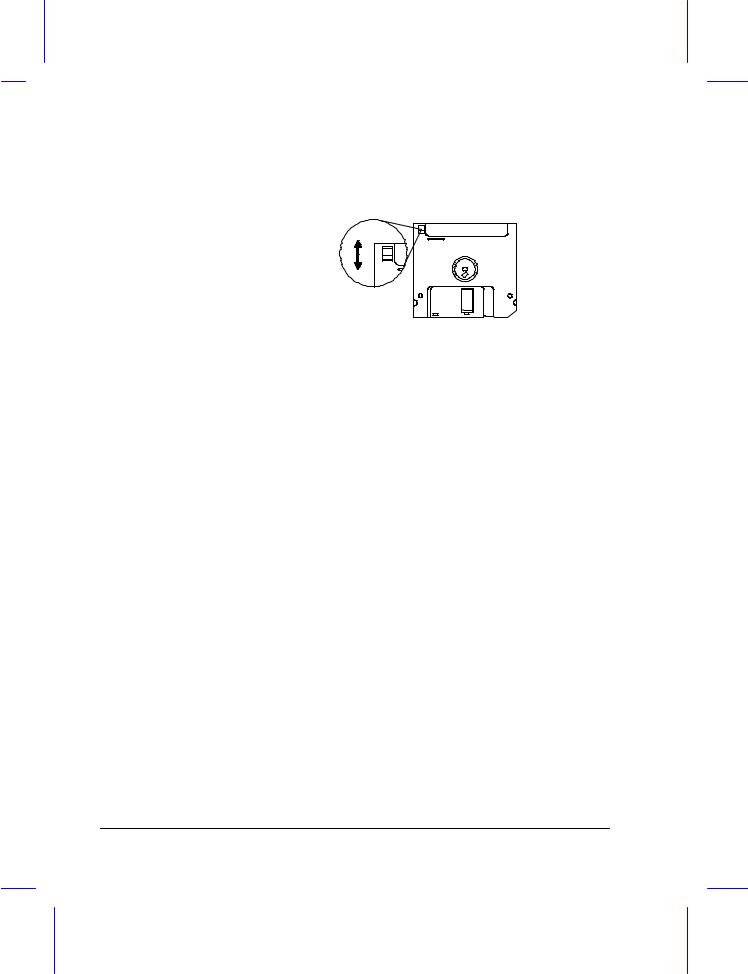
∙Write-protect your diskettes to prevent accidental erasure. To do this, slide the write-protect tab to the write-protect position.
Write-protected
Not write-protected
Figure 1-1 Write-protecting a 3.5-inch Diskette
∙When you put a label on a 3.5-inch diskette, make sure that the label is properly attached (flat on the surface) and within the labelling area (area with slight surface depression) on the diskette. An improperly attached label may cause a diskette to get stuck in the drive when you are inserting or removing it.
1-8 |
User’s Manual |
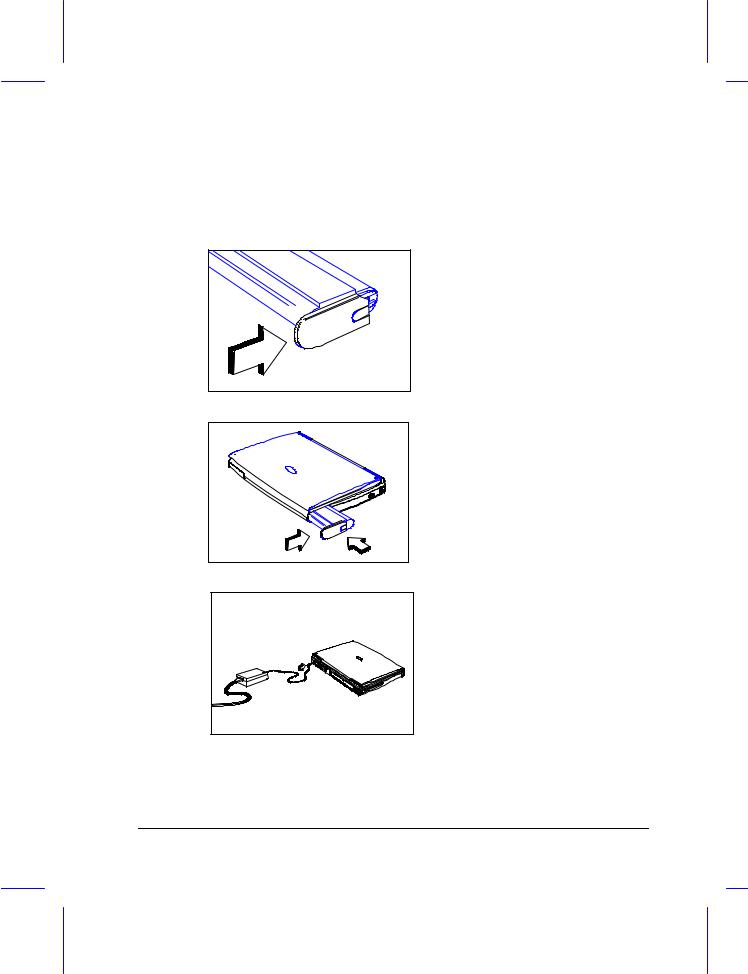
1.3Connecting the Notebook
After reading through the previous section, you are now ready to experience your new AcerNote.
Connecting the Battery Cover
Slide the battery compartment cover over the battery until both the cover and the battery are firmly attached.
Inserting the Battery Pack
Insert the battery pack into the battery compartment and slide the battery compartment cover in place.
Connecting the AC Adapter
Connect one end of the AC adapter to the DC-in port on the notebook’s rear panel and the other end to a properly grounded power outlet.
Getting Started |
1-9 |
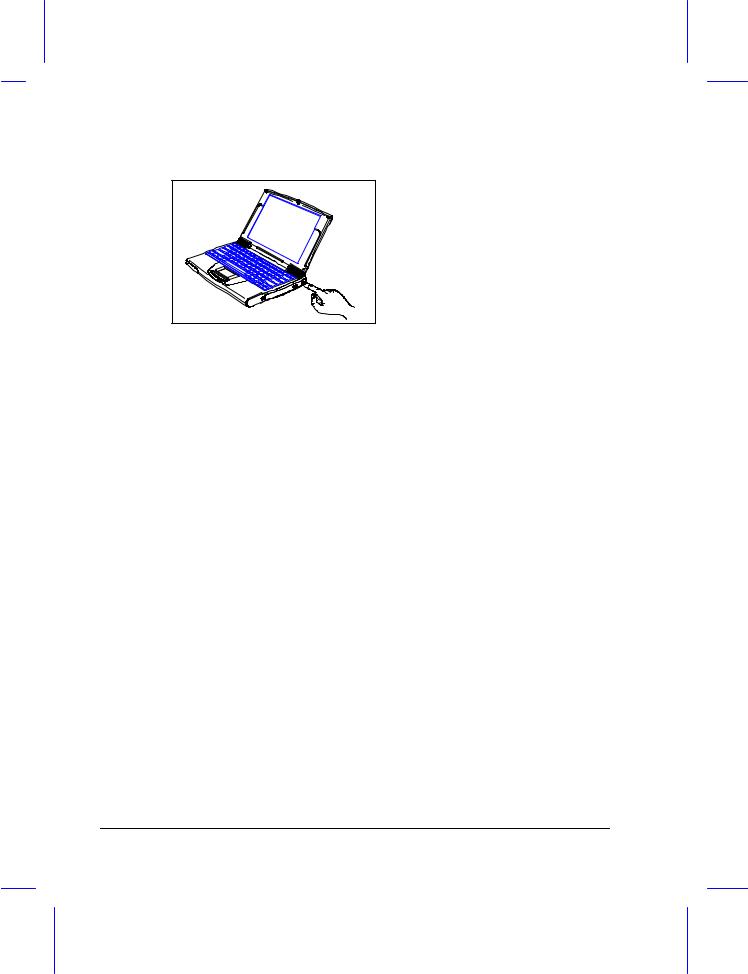
Turning on the Power
Press the power switch to turn on the power.
The POST (Power On Self-Test) routine executes and Windows 95 begins loading.
1-10 |
User’s Manual |

1.4Creating Backup and Startup Diskettes for Windows 95
Entering User Information
When Windows 95 loads for the first time, enter your user information. Have your Windows 95 serial number ready, found in the Windows 95 documentation package.
Creating Backup and Startup Diskettes
If your Windows 95 package contains a Windows 95 CD-ROM, you do not need to create backup diskettes.
Windows 95 prompts you to create backup and startup diskettes. Prepare approximately thirty (30) 3½-inch 1.44MB diskettes for backing up Windows 95 and label them accordingly. Labels are included with the Windows 95 documentation package.
After you are through labelling the disks, begin the backup process.
Do not neglect creating the Windows 95 startup (system) diskette.
If you do not wish to perform the backup at this time, you can skip through this step during Windows 95 setup. Access the Create System Disk tool when you wish to do so. However, we suggest you create these disks as soon as possible.
Now may be the perfect time to read through the user’s manual and get familiar with the AcerNote Light Multimedia.
Getting Started |
1-11 |

1.5Getting Help Online
This user’s manual provides clear and concise information about the notebook, so read it thoroughly. To provide you with help when traveling, the notebook has a comprehensive online help.
Accessing Online Help
Follow these steps to access the online documentation:
1.Press the Windows logo button or Click on the Start button.
2.Select Programs.
3.Click on AcerNote Light Multimedia.
4.Select Online Help.
The online help is easy to navigate with hypertext and hypergraphics. Clear illustrations help describe notebook operation as well.
Getting Online
If you are connected to the Internet and have World Wide Web access, visit our home page (http://www.acer.com/) and get the latest information about our products.
1-12 |
User’s Manual |

C h a p t e r 2
System Tour
This notebook combines high-performance, versatility, power management features and multimedia capabilities in a unique and stylish design case. Work with unmatched productivity and reliability with your new power computing partner.
This chapter gives an in-depth “tour” of the notebook’s many features.
System Tour |
2-1 |

2.1Features
The notebook was designed with the user in mind. Here are just a few of the notebook’s many features:
Performance
∙High-end Pentium microprocessor
∙64-bit main memory
∙Large LCD display and PCI local bus video with graphics acceleration
∙Internal 3.5-inch floppy drive or CD-ROM drive
∙High-capacity, Enhanced-IDE hard disk
∙Lithium-Ion or Nickel Metal-Hydride smart battery pack
∙Power management system with zero-volt suspend-to-disk functionality
Multimedia
∙
∙
∙
16-bit stereo audio
Built-in dual speakers
Ultra-slim, high-speed CD-ROM drive1
1 |
Some areas or regions may not offer the AcerNote Light Multimedia with a built-in CD-ROM drive. |
|
|
2-2 |
User’s Manual |

Human-centric Design and Ergonomics
∙Lightweight and slim
∙Sleek, smooth and stylish design
∙Full-sized keyboard
∙Wide and curved palm rest
∙Centrally-located touchpad pointing device
Expansion
∙PC card (formerly PCMCIA) slots (two type II/I or one type III) with ZV (Zoomed Video) port support
∙Upgradeable memory, hard disk and CPU
System Tour |
2-3 |
